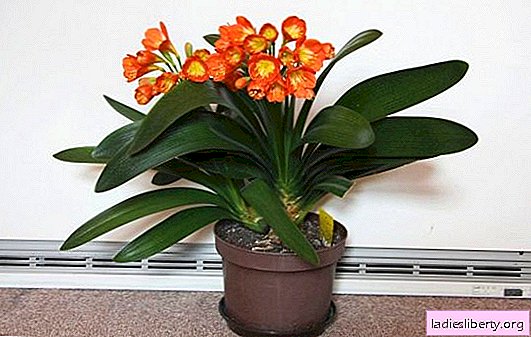
Clivia is a beautiful tropical plant that looks spectacular not only during flowering.
By the way, it blooms in the middle or end of winter, when the rest of the indoor plants have a dormant period. To enjoy the bright bells of clivia annually, care for the plant at home should be complete.
Features of the content of clivia in the room
Clivia belongs to the Amaryllis family, but it does not have a bulb, and there is a juicy rhizome with thick roots. The leaves are collected in a basal rosette, do not die during dormancy. The flower stalk of the plant is powerful, with good care reaches 40 cm in height. It develops about 30 large bells, which open one by one. Flowering lasts more than a month.
Clivia is not a moody plant, but loves peace. No need to constantly rearrange the pot from place to place, especially during the formation of buds. It’s better to immediately determine the correct location.
Where to put the pot with clivia?
A tropical plant does not tolerate direct sunlight. It is better to arrange a flower pot so that the dining sun does not burn the leaves. Take it to the eastern or western windows, but if this is not possible, then you will have to shade the plant on the southern windowsill. On windows of northern orientation, clivia is contained only at rest.
All about humidity and temperature
Clivia loves fresh air, so the room needs to be ventilated regularly. In summer, it is better to take the pot out into the air, but place it in partial shade, so that rain and bright sunlight will not fall. In winter, the room is ventilated, but there should not be a draft, otherwise the flower will suffer.
Humidity in the room does not play a special role, clivia does not need frequent spraying, it is enough to wipe the leaves from accumulated dust. But much depends on the temperature regime. For normal growth and development, the temperature is maintained at +20 ° C, but during the rest period it is reduced to +16 ° C.
How to care for clivia at home throughout the year
A tropical plant prefers moderately moist soil. Between waterings, the substrate in the pot should dry out, otherwise root system diseases cannot be avoided. Please note that the flower can not be watered with tap water, it is better to use standing or boiled water.
During the dormant period, the plant is watered sparingly, but from the moment buds are formed, the amount of water is gradually increased. To prevent root decay, the pot should have drainage holes. An hour after watering, water is poured from the pan.
When to feed Clivia
Additional nutrition is introduced only during the formation of buds and flowering. Ready-made water-soluble mineral complexes with a low nitrogen content are used. If there is a lot of this element, then clivia will grow leaves, and you can forget about flowering.
Fertilizer application:
• The first top dressing is given after the peduncle appears;
• the second with an interval of 2 weeks;
• third in 3 weeks if clivia bloomed.
The flower is fed every 14 days until the buds are opened, after this fertilizer is applied every 3-4 weeks. After flowering, all feeding is stopped.
How to care for clivia in the fall
In September, a young plant begins a dormant period, which lasts about two months. Adult specimens that have already bloomed rest from October to February, and at the end of winter they begin to produce peduncles. During the rest period, the plant must be properly looked after. It is best to send the pot to a glazed loggia or put it in a cool room where the temperature will not drop below +12 ° C. With sufficient humidity, the flower can not be watered at all.
Clivia transplant according to all the rules
A tropical flower does not like transplants and reacts poorly to them, so you need to approach the issue responsibly, otherwise the plant will die. Often it is not necessary to disturb the root system, it is enough to transplant it every 2-3 years. What is the reason for this?
All the vitality and necessary moisture accumulate in the fleshy roots of the plant; transplanting can not do without injuries. And this leads to rotting and death.

Advice! If the root has broken off during transplantation, then treat it with crushed coal.
Transplant Rules:
• choose a small pot; clivia blooms well only in a tight container;
• select loose, light soil; a mixture of leaf humus, turfy soil and sand is suitable;
• plan a transplant at the end of spring when clivia has faded;
• pour a quarter of the pot bottom with drainage, pebbles, broken bricks, expanded clay will do;
• the root neck of the flower is left on the surface of the soil, otherwise the lower leaves will rot.
Young plants can be transplanted annually, and specimens older than 10 years do not transplant at all. Every year, the topsoil is changed in the pot, more nutritious soil is poured.

During the transplant, daughter plants are carefully separated, which are planted separately.

Florist mistakes and difficulties in caring for clivia at home
Clivia is an unpretentious plant, but still inexperienced gardeners may have difficulty growing it. We will discuss all the problems and how to solve them.
Clivia leaves turn yellow
This is not always caused by improper care, perhaps a natural aging process is in progress, when new ones replace them. But there are other cases:
1. Leaves turn yellow from insufficient or excessive watering, they become soft. In this case, remove the flower from the pot, check the condition of the roots, remove any rotten or dry, plant in a new substrate. Monitor the amount of moisture in the soil.
2. Yellowing of the leaf plate occurs due to lack of nutrients. In this case, the color is lost gradually, the whole plant looks dull. If clivia has not been fertilized for a long time, then simply feed the plant.
3. The leaves turn yellow after flowering, as the fruit begins to form. It is necessary to remove the flower arrow in time to prevent this.
Often, yellowing of the leaves leads to frequent turning of the pot, draft or long exposure to the sun.
Brown spots at the ends and sheet plate
If spots appear only from the end of the leaf, then this indicates an excess of moisture in the soil. Adjust the watering, always pour excess fluid from the pan.
When the spots are located on the entire surface of the leaf, the plant was affected by sunlight.
Leaves rot
Wet leaves should alert the grower. This condition indicates the root rot of the plant. Perhaps the roots were damaged during the transplant or the flower was flooded. You need to remove clivia from the pot, inspect the root system, remove all rotten roots, treat with potassium permanganate and plant in fresh soil.
Dark spots and growths on the leaves
If the air in the room is too dry, then the plant is affected by a scab. Dark spots and peculiar growths can be found on the leaves - this is the pest. He leads a sedentary lifestyle. Soap solution or insecticides will help get rid of scabs. All growths are removed with a damp cloth moistened in solution. Additionally spray the plant to destroy the larvae.











